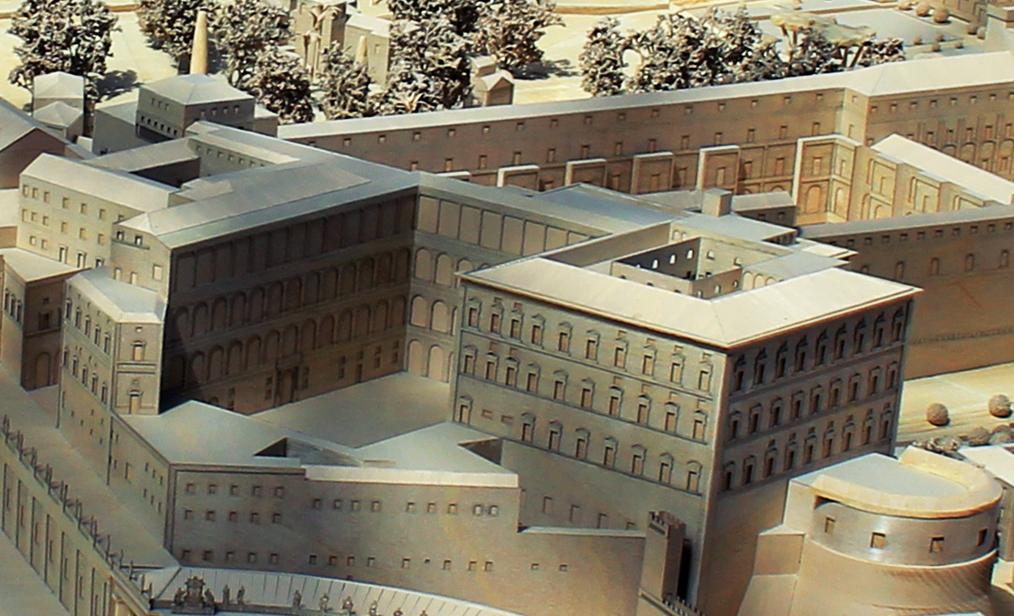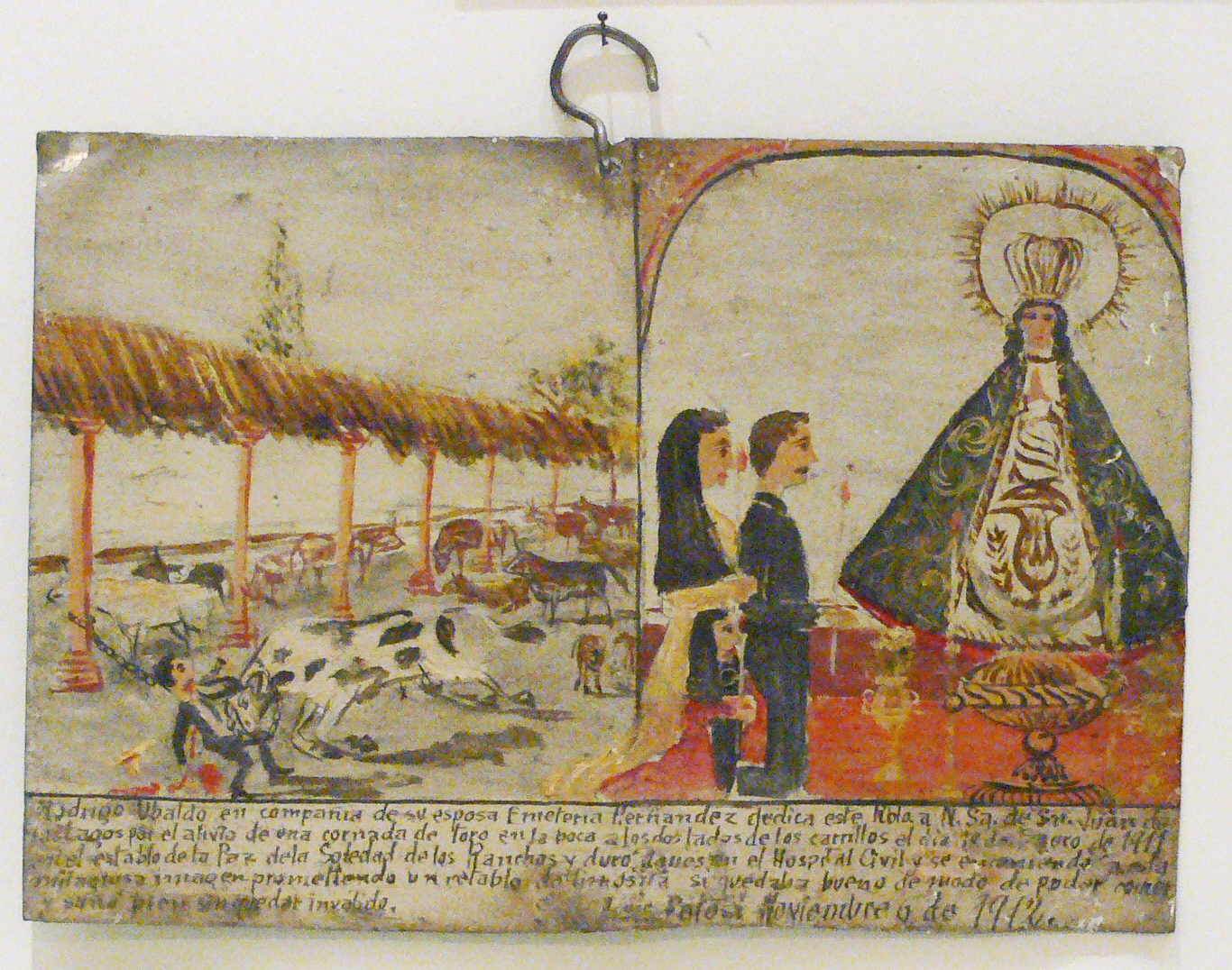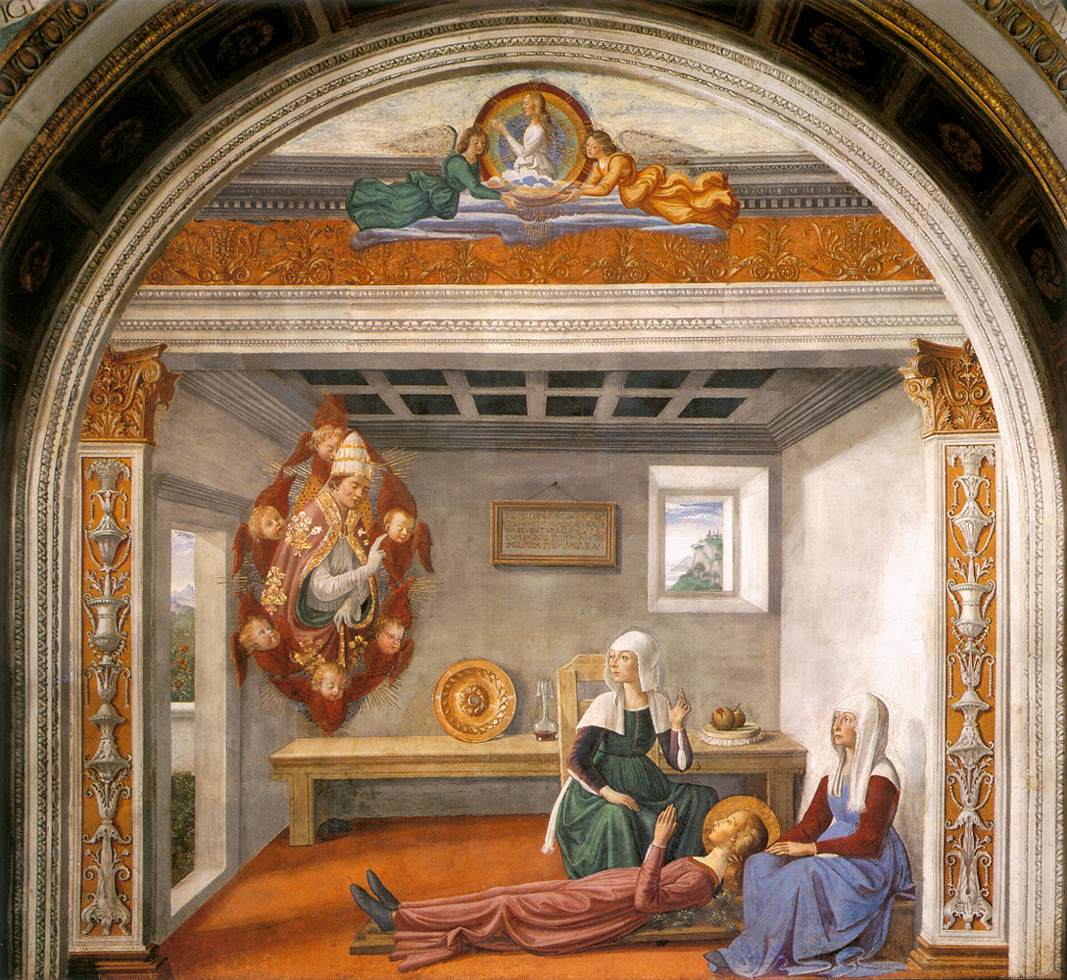|
Santa Maria Della Quercia, Viterbo
The Basilica of Santa Maria della Quercia is a Renaissance-style, Roman Catholic sanctuary church and minor basilica, about two kilometer outside of the center of Viterbo, on the road to Bagnaia, in the Region of Lazio, Italy. History In 1417, a local artist painted an icon of the Virgin following the design of a local painter Maestro Martello. The image was placed on an oak tree in the countryside, and became a source of veneration, which only increased in 1467 during a scourge of the plague. Miracles were attributed to the icon, and the image was ensconced in a chapel. An altar was erected in 1467 and a chapel commissioned by Pope Paul II. The chapel was initially affiliated with the Gesuati order, a Tuscan order which specialized in the aid to pilgrims. Within a few years, Franciscan monks substituted the priests of the Gesuati order and commissioned this larger church, built between 1470 and 1525. On the 8 of April 1578, the church was consecrated by the Cardinal Francesc ... [...More Info...] [...Related Items...] OR: [Wikipedia] [Google] [Baidu] |
Antonio Da Sangallo The Younger
Antonio da Sangallo the Younger (12 April 14843 August 1546), also known as Antonio Cordiani, was an Italian architect active during the Renaissance, mainly in Rome and the Papal States. One of his most popular projects that he worked on designing is St. Peter’s basilica in the Vatican City. He was also an engineer who worked on restoring several buildings. His success was greatly due to his contracts with renowned artists during his time. Sangallo died in Terni, Italy, and was buried in St. Peter’s Basilica. Early life and apprenticeship Sangallo was born Antonio Cordiani in Florence, the son of Bartolomeo Piccioni. His grandfather Francesco Giamberti was a woodworker, and his uncles Giuliano and Antonio da Sangallo were noted architects of the time. Despite his family ties, Cordiani spent his early life in poverty, resulting from the political and religious turmoil of the fifteenth century. At around age twenty, in 1503, young Cordiani followed his uncles to Rome in ... [...More Info...] [...Related Items...] OR: [Wikipedia] [Google] [Baidu] |
Minor Basilicas In Lazio
Minor may refer to: Common meanings * Minor (law), a person not under the age of certain legal activities. * Academic minor, a secondary field of study in undergraduate education Mathematics * Minor (graph theory), a relation of one graph to another * Minor (matroid theory), a relation of one matroid to another * Minor (linear algebra), the determinant of a square submatrix Music * Minor chord * Minor interval * Minor key * Minor scale People * Minor (given name), a masculine given name * Minor (surname), a surname Places in the United States * Minor, Alabama, a census-designated place * Minor, Virginia, an unincorporated community * Minor Creek (California) * Minor Creek (Missouri) * Minor Glacier, Wyoming Sports * Minor, a grade in Gaelic games; also, a person who qualifies to play in that grade * Minor league, a sports league not regarded as a premier league ** Minor League Baseball or "the minors", the North American professional baseball leagues affiliated to but bel ... [...More Info...] [...Related Items...] OR: [Wikipedia] [Google] [Baidu] |
Roman Catholic Churches In Viterbo
Roman or Romans most often refers to: *Rome, the capital city of Italy *Ancient Rome, Roman civilization from 8th century BC to 5th century AD *Roman people, the people of Roman civilization *Epistle to the Romans, shortened to Romans, a letter written by Paul, found in the New Testament of the Christian Bible * Ar-Rum (), the 30th sura of the Quran. Roman or Romans may also refer to: Arts and entertainment Music *Romans (band), a Japanese pop group * ''Roman'' (album), by Sound Horizon, 2006 * ''Roman'' (EP), by Teen Top, 2011 *"Roman (My Dear Boy)", a 2004 single by Morning Musume Film and television *Film Roman, an American animation studio * ''Roman'' (film), a 2006 American suspense-horror film * ''Romans'' (2013 film), an Indian Malayalam comedy film * ''Romans'' (2017 film), a British drama film * ''The Romans'' (''Doctor Who''), a serial in British TV series People *Roman (given name), a given name, including a list of people and fictional characters *Roman (surname), ... [...More Info...] [...Related Items...] OR: [Wikipedia] [Google] [Baidu] |
Pius IX
Pope Pius IX (; born Giovanni Maria Battista Pietro Pellegrino Isidoro Mastai-Ferretti; 13 May 1792 – 7 February 1878) was head of the Catholic Church from 1846 to 1878. His reign of nearly 32 years is the longest verified of any pope in history; if including unverified reigns, his reign was second to that of Peter the Apostle. He was notable for convoking the First Vatican Council in 1868 and for permanently losing control of the Papal States in 1870 to the Kingdom of Italy. Thereafter, he refused to leave Vatican City, declaring himself a " prisoner in the Vatican". At the time of his election, he was a liberal reformer, but his approach changed after the Revolutions of 1848. Upon the assassination of his prime minister, Pellegrino Rossi, Pius fled Rome and excommunicated all participants in the short-lived Roman Republic. After its suppression by the French army and his return in 1850, his policies and doctrinal pronouncements became increasingly conservative. He was resp ... [...More Info...] [...Related Items...] OR: [Wikipedia] [Google] [Baidu] |
Ex-voto
An ex-voto is a votive offering to a saint or a divinity, given in fulfillment of a vow (hence the Latin term, short for ''ex voto suscepto'', "from the vow made") or in gratitude or devotion. The term is usually restricted to Christian examples. Definition Ex-votos are placed in a Church (building), church or chapel where the worshiper seeks grace or wishes to give thanks. The destinations of pilgrimages often include shrines decorated with ex-votos. Ex-votos can take a wide variety of forms. They are not only intended for the invocated, but also as a testimony to later visitors of the received help. As such they may include texts explaining a miracle attributed to the helper, or symbols such as a painted or modeled reproduction of a miraculously healed body part, or a directly related item such as a crutch given by a person formerly lame. There are places where a very old tradition of depositing ex-votos existed, such as Abydos, Egypt, Abydos in ancient Egypt. Ex-voto paint ... [...More Info...] [...Related Items...] OR: [Wikipedia] [Google] [Baidu] |
Mariotto Albertinelli
Mariotto di Bindo di Biagio Albertinelli (13 October 1474 – 5 November 1515) was an Italian Renaissance painter active in Florence. He was a close friend and collaborator of Fra Bartolomeo.Ludovico Borgo and Margot Borgo.Albertinelli, Mariotto. Grove Art Online. Oxford Art Online. Oxford University Press. Web. 20 May 2016 Some of his works have been described as "archaic" or "conservative"; others are considered exemplary of the grandiose classicism of High Renaissance art. Life and work Albertinelli was born in Florence to a local goldbeater, gold beater. He was a pupil of Cosimo Rosselli, in whose workshop he met Baccio della Porta, later known as Fra Bartolomeo. The two were so close that in 1494 they formed a "compagnia," or partnership, in which they operating a joint studio and divided the profits of anything produced within it. The partnership lasted until 1500, when Baccio joined the Dominican order and spent two years in cloister. At the beginning of his career Al ... [...More Info...] [...Related Items...] OR: [Wikipedia] [Google] [Baidu] |
Il Truffetta
Monaldo Trofi -- also known as ''Monaldo Corso'' or ''Monaldo da Viterbo'' or ''il Truffetta'' -- (active 1505-circa 1539) was an Italian painter of the Renaissance active in Viterbo, region of Lazio, Italy. Biography Trofi was said to have been born in Viterbo in the late 1480s, but it is unclear with whom he trained. The obvious cited master is Antonio del Massaro (ca. 1450–1516), the main local artist of the prior generation. His style sometimes resembles Luca Signorelli. He is documented in 1504 in association with works at the Corneto Cathedral with the two painters above and Constantino di Jacopo di Zello. Most of his output, signed or attributed, are sacred paintings. He is said to have painted a ''Nativity'' for a church in Canino He also painted an ''Enthroned Madonna and Child between St John Evangelist, St Francis of Assisi, St Jerome and St John the Baptist'' for the church of San Francesco in Canino. The Walters Art Gallery in Baltimore has two tablets depicting ... [...More Info...] [...Related Items...] OR: [Wikipedia] [Google] [Baidu] |
Tondo (art)
A ''tondo'' (: ''tondi'' or ''tondos'') is a Renaissance term for a circular work of art, either a painting or a sculpture. The word derives from the Italian ''rotondo'', "round". The term is usually not used in English for small round paintings, but only those over about 60 cm (two feet) in diameter, thus excluding many round portrait miniatures – for sculpture the threshold is rather lower. A circular or oval relief sculpture is also called a roundel. The infrequently-encountered synonym rondoArtlex.com . usually refers to the musical form. History Artists have created ''tondi'' since antiquity. T ...[...More Info...] [...Related Items...] OR: [Wikipedia] [Google] [Baidu] |
Intarsia
Intarsia is a form of wood inlaying that is similar to marquetry. The practice dates from before the seventh century AD. The technique inserts sections of wood (at times with contrasting ivory or bone, or mother-of-pearl) within the solid wood matrix of floors and walls or of tabletops and other furniture; by contrast marquetry assembles a pattern out of veneers glued upon the carcass. '' Certosina'' is a variant also using pieces of ivory, bone or mother of pearl. Intarsia is mostly used of Italian, or at least European work. Similar techniques are found over much of Asia and the Middle East. The word is from the Italian, derived from Arabic. History When Egypt came under Arab rule in the seventh century, indigenous arts of intarsia and wood inlay, which lent themselves to non-representational decors and tiling patterns, spread throughout the Maghreb. The technique of intarsia was already perfected in Islamic North Africa before it was introduced into Christian Europe ... [...More Info...] [...Related Items...] OR: [Wikipedia] [Google] [Baidu] |
Domenico Ghirlandaio
Domenico di Tommaso Curradi di Doffo Bigordi (2 June 1448 – 11 January 1494), professionally known as Domenico Ghirlandaio (also spelt as Ghirlandajo), was an Italian Renaissance painter born in Florence. Ghirlandaio was part of the so-called "third generation" of the Florentine Renaissance, along with Verrocchio, the Pollaiolo brothers and Sandro Botticelli. Ghirlandaio led a large and efficient workshop that included his brothers Davide Ghirlandaio and Benedetto Ghirlandaio, his brother-in-law Bastiano Mainardi from San Gimignano, and later his son Ridolfo Ghirlandaio. Many apprentices passed through Ghirlandaio's workshop, including Michelangelo. His particular talent lay in his ability to posit depictions of contemporary life and portraits of contemporary people within the context of religious narratives, bringing him great popularity and many large commissions.Toman, Rolf Life and works Early years Ghirlandaio was born Domenico di Tommaso di Currado di D ... [...More Info...] [...Related Items...] OR: [Wikipedia] [Google] [Baidu] |
Michele Tosini
Michele Tosini, also called ''Michele di Ridolfo'', (1503–1577) was an Italian painter of the Renaissance and Mannerist period, who worked in Florence. Biography He apprenticed initially with Lorenzo di Credi and Antonio del Ceraiolo, but then moved into the studio of Ridolfo Ghirlandaio, from whom he acquired the name ''Michele di Ridolfo'' or ''Michele (di Ridolfo) del Ghirlandaio''. Some sources claim Tosini was the son of Ridolfo, Freedberg, Sydney J. ''Painting in Italy, 1500–1600'', 3rd edn., page 620, 1993, Yale, but he was just a student of him. Tosini began painting in the early 16th-century Florentine style of Fra Bartolommeo and Andrea del Sarto (e.g. the ''Virgin of the Sacred Girdle'', c. 1525; Florence, San Marco). His acceptance of Mannerism was slow, but by the 1540s the influence of Salviati and Bronzino was visible in his work. After 1556, Tosini served as an assistant to Giorgio Vasari in the decoration of the ''Salone dei Cinquecento'' in the Palazz ... [...More Info...] [...Related Items...] OR: [Wikipedia] [Google] [Baidu] |





